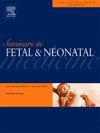早产儿脂肪量的短期和长期生长和发展。
IF 2.9
3区 医学
Q1 PEDIATRICS
引用次数: 0
摘要
早产儿的生长速度通常比足月出生的婴儿快,通常在六到八周内体重会增加一倍。然而,许多人面临着导致生长迟缓和神经发育不佳的挑战。为了达到最佳生长,这些婴儿通常需要强化母乳或高营养配方奶粉。虽然达到营养和生长目标至关重要,但人们对婴儿在追赶阶段的产后快速生长感到担忧,特别是在足月矫正年龄时体脂增加,这可能增加他们以后患肥胖症和慢性疾病的风险。然而,有证据表明,尽管早产儿在足月矫正年龄时可能有较高的体脂,但这种差异在3个月矫正年龄时就会减弱,与足月婴儿更接近。对2万多人的系统回顾发现,小于胎龄的早产儿在儿童期和成年期没有更高的肥胖;相反,他们表现出较低的身体质量指数、腰围、相似的身体和内脏脂肪和血压,与同龄的胎龄早产儿相比。因此,当涉及到支持长期代谢结果和神经发育时,促进早产儿的早期生长并不一定需要权衡,这是令人放心的。医疗保健提供者应鼓励反应性喂养方法,即使是早产儿,根据婴儿的生理需求,饥饿和饱腹感,一旦他们表现出喂养线索的指导。这种方法尊重儿童的发展需要,鼓励健康的饮食习惯,培养积极的亲子喂养关系,最终使儿童在不损害其长期健康结果的情况下成长和发展,充分发挥其潜力。本文章由计算机程序翻译,如有差异,请以英文原文为准。
Short- and longer-term growth and development of fat mass in preterm infants
Preterm infants typically experience faster growth rates than term-born infants, often doubling their weight in six to eight weeks. However, many face challenges leading to growth faltering and suboptimal neurodevelopment. To achieve optimal growth, these infants often require fortified breastmilk or high-nutrient formula. While meeting nutrition and growth targets are essential, concerns arise about rapid postnatal growth during their catch-up phase, particularly regarding increased body fat at term-corrected age, possibly increasing their risk for obesity and chronic health conditions later. However, evidence suggests that although preterm infants may have higher body fat at term-corrected age, this difference diminishes by three months corrected age, aligning more closely with term-born infants. Systematic reviews of more than 20,000 individuals observed that small for gestational age preterm infants do not have higher adiposity in childhood and adulthood; rather, they exhibit lower body mass indexes, waist circumferences, similar body and visceral fat and blood pressure compared to their appropriate for gestational age preterm-born peers. Therefore, it is reassuring that promoting early growth in preterm infants does not necessitate a trade-off when it comes to supporting long-term metabolic outcomes versus neurodevelopment. Healthcare providers should encourage a responsive feeding approach, even in preterm infants, guided by infants' physiological needs, hunger and satiety once they exhibit feeding cues. This approach respects the child's developmental needs and encourages healthy eating habits, fostering positive parent-child feeding relationships, and ultimately allowing the child to grow and develop to their full potential without compromising their long-term health outcomes.
求助全文
通过发布文献求助,成功后即可免费获取论文全文。
去求助
来源期刊
CiteScore
6.40
自引率
3.30%
发文量
49
审稿时长
6-12 weeks
期刊介绍:
Seminars in Fetal & Neonatal Medicine (formerly Seminars in Neonatology) is a bi-monthly journal which publishes topic-based issues, including current ''Hot Topics'' on the latest advances in fetal and neonatal medicine. The Journal is of interest to obstetricians and maternal-fetal medicine specialists.
The Journal commissions review-based content covering current clinical opinion on the care and treatment of the pregnant patient and the neonate and draws on the necessary specialist knowledge, including that of the pediatric pulmonologist, the pediatric infectious disease specialist, the surgeon, as well as the general pediatrician and obstetrician.
Each topic-based issue is edited by an authority in their field and contains 8-10 articles.
Seminars in Fetal & Neonatal Medicine provides:
• Coverage of major developments in neonatal care;
• Value to practising neonatologists, consultant and trainee pediatricians, obstetricians, midwives and fetal medicine specialists wishing to extend their knowledge in this field;
• Up-to-date information in an attractive and relevant format.

 求助内容:
求助内容: 应助结果提醒方式:
应助结果提醒方式:


